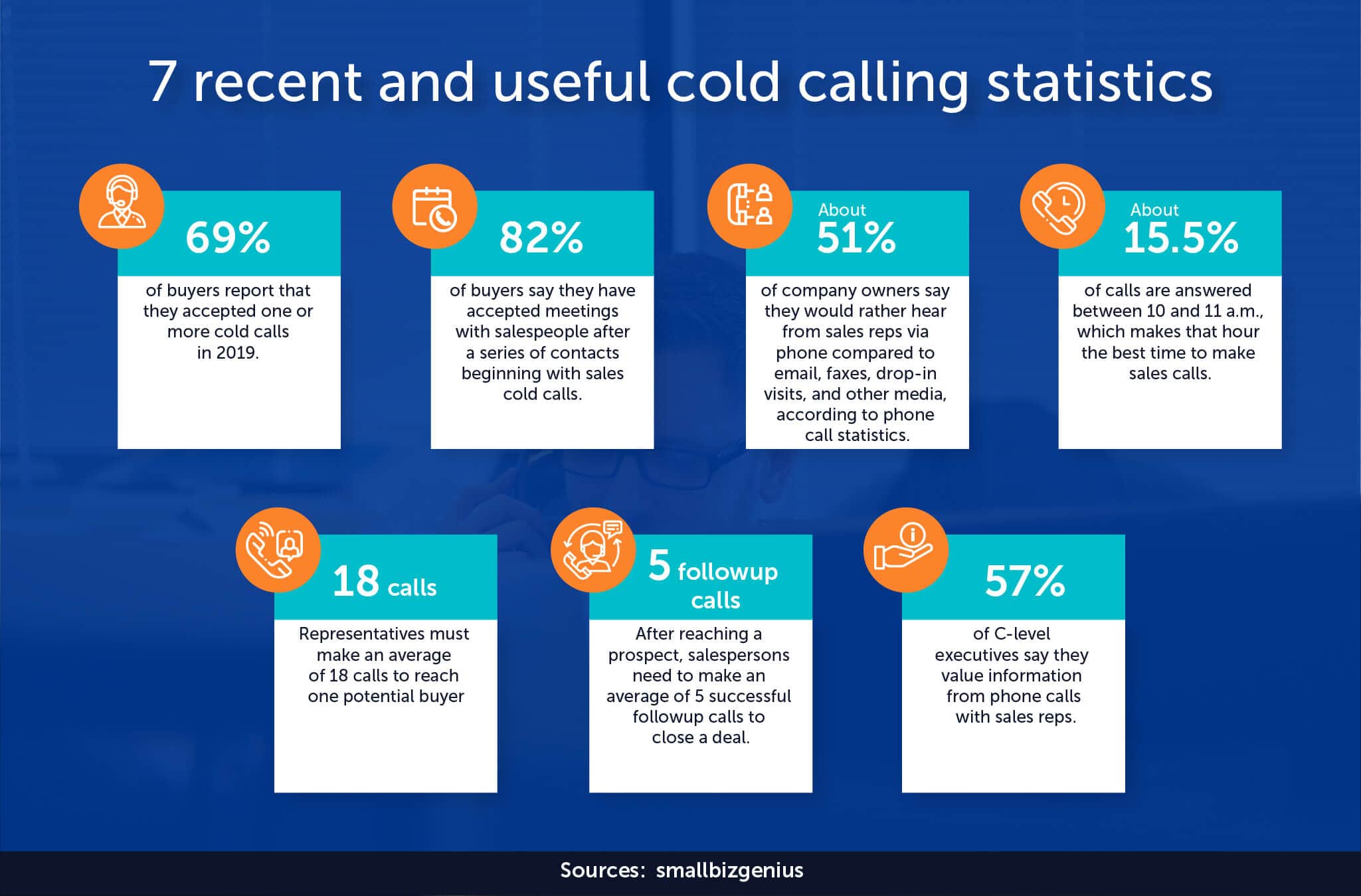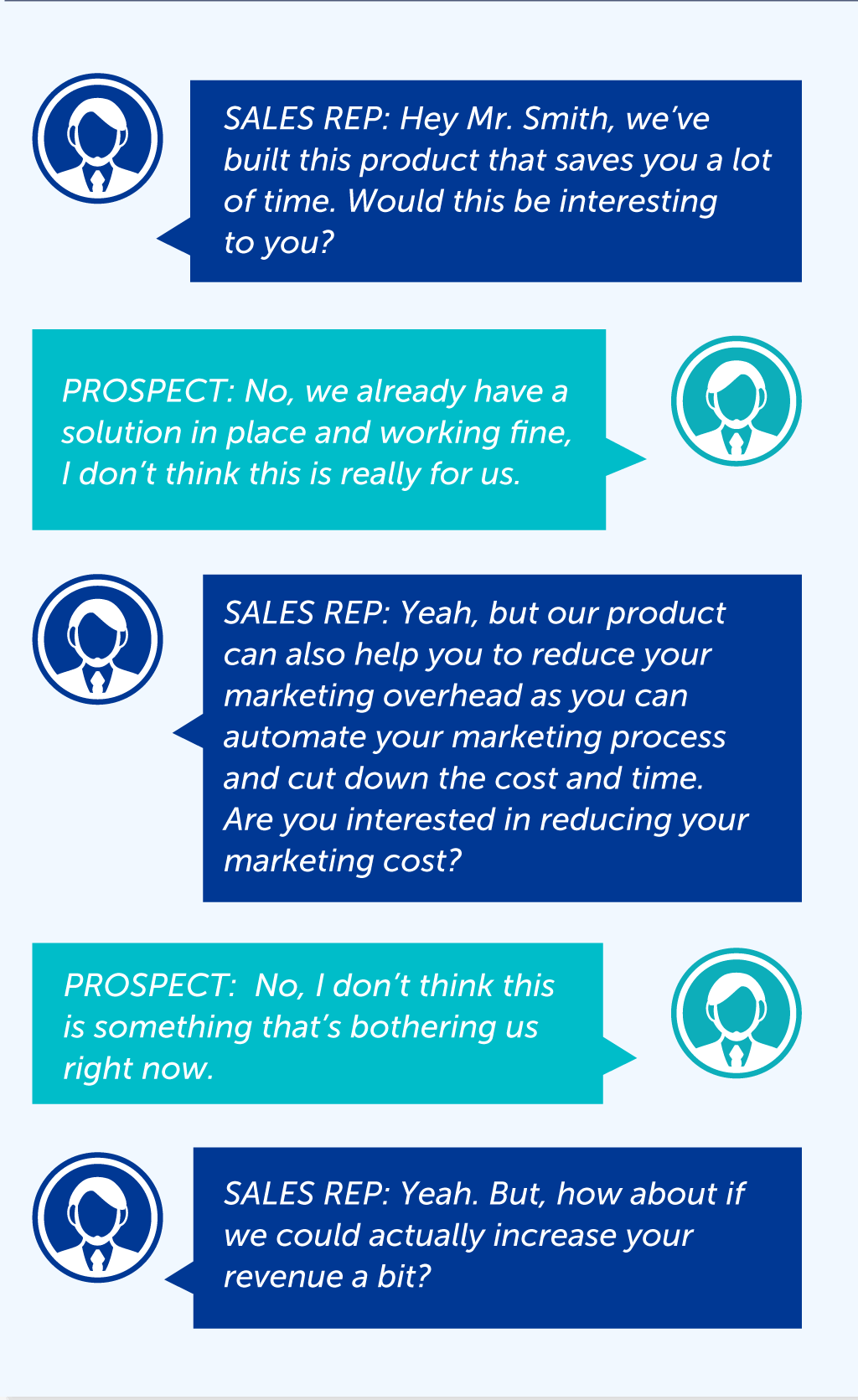People continue to say that B2B cold calling is dead, however, many successful businesses rely on cold calling to drive revenue. Businesses have sales reps aggressively dial numbers day in and day out, whether they are Fortune 500 firms or high-growth startups.
What is Cold Calling in Sales?
Cold calling is a traditional way to reach prospects. It is simply picking up the phone and calling the list of prospects hoping to convert.
What is The Purpose of Cold Calling?
The objective of cold calling is to engage a prospect in a dialogue about their requirements and decide the next steps.
At times, cold-calling potential prospects can be difficult and frustrating. Cold calling is old-fashioned but remains an important part of the sales process, where strangers are turned into prospects. CEOs and other top executives say they prefer email and other media to phone calls, particularly in the early stages of planning a project.
Really?
Yeah. Here are some useful B2B cold calling statistics.
7 Recent and Useful Cold Calling Statistics

If you feel overwhelmed by these numbers, you’re not alone. However, B2B cold calling is not as easy as it looks from the outside.
No two calls are the same, which makes the experience exciting and, at times, frightening. You need to take the right approach and attitude before you start calling your target list.
7 Cold Calling Tips for B2B Companies
Let us dive into seven must-follow cold calling tips you will need to learn to nail this year’s cold calling game.
1. Set a Cold Calling Process and Benchmark
Prospecting is never easy if you do not have a process and benchmarks to ensure sales productivity. Take some time to audit your cold calling process and brainstorm ways to improve your outbound cold calling. There are many opportunities to optimize the cold calling process. Start with answering a few important questions.
- How many leads do you have?
- How many calls do you make?
- How many decision-makers do you actually reach? (reach rate)
- How many of the people you reach are actually qualified to buy your product?
- How many of these qualified opportunities do you close?
Once you have these numbers, you will be in a better position to decide which stage of your cold calling process needs improvement.
2. Respect Your Prospect’s Time
When you call a prospect cold, you are essentially intruding into their time. Therefore, proving your value within the first few seconds of the call is vital, or the prospect may end the conversation then and there. Asking for permission to go ahead with detailed information often helps in this situation.
For instance, you may ask something specific like “May I take 45 seconds of your time to [value statement]” to raise the attention of your prospect and also gain their consent to further speaking.
It is important to keep the conversation short and simple even after the prospect gives you the go-ahead while focusing on the next steps to schedule a meeting or demo where you can move the deal.
It is always a good practice to have a targeted list of prospects before you even begin calling instead of making random calls. Make the most of your time and that of your prospects by calling prospects who match your decision-makers.
3. Are You Pitching Pre-Maturely?
This is a very common mistake sales reps do when their prospects call cold. 84% of buyers complain that sales reps are annoying in their efforts to convince them to buy. They launch into a pitch way too early, without first understanding what the prospect wants and whether your offer can really help them in any way.
Do you wonder why prospects hate listening to most of your sales pitches? Because most of the sales reps think what they like about a pen (for instance), prospects also like about a pen. Instead of collecting information, engaging the prospect, and proposing the answer in response to their discovering evidence, they just jump right into a generic pitch.
Suppose you are selling your SaaS product to Mr. Smith (who is a marketing manager at your potential account) on a call, and after a quick intro, you launch into your pitch, full of enthusiasm.

And the sales rep goes on throwing darts in the dark without any clear target.
SalesIntel helps you with additional information on your prospects including technographic and firmographic data. This helps you tailor your sales pitch to keep the conversation engaging and meaningful. Additionally, SalesIntel also helps you to identify the accounts that are actively looking for similar products or services like yours using buying intent data.
4. Prepare for Common Objections
Like it or not, hearing no is a natural aspect of cold calling, so you have to learn how to handle the objections that arise in your conversations. Here are the three most common objections you will encounter when doing cold calls. Prepare your answers, and practice them in advance.
#1: “Send me an email”
Asking to send an email is a typical objection that your prospects make to getting off the phone. A perfect response to keeping them engaged is to say, “I’m certainly going to, but so I know exactly what to put in my email, you can tell me …” This brings the prospect’s guard down just enough to get a conversation going as well as giving your vital information about their interests and pain points.
#2: “Can you call back after some time”
In this situation, you can ask for a convenient time for a 3 minutes discussion but also tell them, “I want to see if we ‘re even a good fit for you before we follow up.”
This way, you will not sound desperate and will keep the conversation short for limited information. They stay with you on the phone more often than not once they realize it is not going to be a long sales pitch.
#3: “I am going to have a meeting with our management on this, let’s talk next xxxx”
The person you are speaking to may not take an immediate decision as committees are also involved in bigger firms. Your proposal will be discussed with management. That is a great sign. However, you don’t want to let them off the hook without a good idea of what needs to be done between now and the next call.
Ask them who will be involved in the internal meeting. Do they want you to explain the proposal to the management committee? What material do they need in preparation for that meeting?
Framing the next steps paints a clear picture of what needs to be done to move forward in your contact’s head, so the next call will either be a “yes” or a “no”.
5. NEVER Multitask During Sales Calls
Sitting at your desk (or working from home), hours of cold calling can turn into doldrums. Dialing leads, attempting to reach decision-makers, repeatedly hearing the same objections. It is tempting to occupy your brain with more fun distractions while facing objection after objection.
The moment you divert your focus to some other task during the call, you’re likely to miss what your prospect is saying. Truly listening is difficult if you divide your attention between different things. Not having a proper understanding might lead to a loss of opportunity. If you want to be on top of your game, full engagement is a prerequisite.
6. RECOVER From a Bad Sales Call
During a cold call, a particularly painful rejection can completely deflate the salesperson inside you. However, failure is a guaranteed part of your sales process. Not every prospect is a good fit for your solution in any unique situation.
Get some distance from what just happened, so you can have perspective. Just take a minute or two to listen to your favorite song, read some inspiring quotes, or do something that lifts your spirits and puts you in a good state of mind. Do something that is interesting. And then get back for the next call. Pick up the phone, dial a different number, focus, and convert the call to a new opportunity.
7. Follow-Up is Mandatory
According to Marketing Donut, after the initial call, 80% of sales take 5 follow-up phone calls to close. However, in this report, it was found that nearly half of salespeople give up after only one follow-up. A successful follow-up strategy always puts you ahead of the curve.
Make sure you are adding value to each follow-up call to increase your chances of winning the deal. Never end a call without conveying the next step. Salespeople have to close every interaction with a clearly defined plan. This can be to set up a next call/meeting, schedule an on-site visit, or even arrange a presentation for other stakeholders to reinforce the importance of your solution.
So whether it is following up on an appointment or dialing out hoping someone picks up – keeping this practice, in the long run, is worth it all.

7 B2B Cold Calling Techniques to Improve Your Conversions Using SalesIntel
It is clear that cold calling techniques have changed drastically with the introduction of sales intelligence platforms. The cliche of a sales professional rifling through a stack of anonymous prospects is no longer productive. There are different ways to improve your cold calling conversions with SalesIntel. Take advantage of them!
1. Convert Your Cold Call Into a Warm Call
Your initial contact with new prospects doesn’t have to be a cold call. You can warm up your prospect by first doing some research on the prospect using SalesIntel before calling to better engage the prospect. Secondly, you can familiarize the prospect with your name or your company affiliation before the call by connecting with them on LinkedIn or commenting on their LinkedIn post.
2. Avoid the Gate-keepers and Reach Directly to the Decision-Makers
SalesIntel helps you with over 48 million work mobile numbers so that you can get to a decision-maker straight away, and use that time for more important tasks than waiting on a switchboard operator or leaving a voicemail.
A survey by ScaleX has revealed that sales professionals are 7X more likely to reach prospects using SalesIntel work mobile numbers.
3. Get All the Required Information About Your Ideal Customer Profile
In addition to the direct work mobile numbers, SalesIntel offers you comprehensive B2B Data that includes human-verified technographic data, firmographic data, intent data, and more. You can also fill in the data gaps in your inbound and event leads or any existing B2B data list within a few clicks with our data enrichment feature. Complete data allows you to take a more focused approach while prospecting and selling
4. Know the Intention of Your Prospects
Before you pick up the phone and start calling your list of prospects, it is always good to know their intent. Are they looking for a similar product/ service or want to explore it at the early stage of the buying cycle? Remember, no matter how well you define your ideal customer profile, at any given time only about 15% of those companies will be ready to buy. Buyer Intent data allows you to tailor your sales pitch accordingly and get involved in a conversion-focused conversation.
SalesIntel helps you to get the intent signals you need so that you don’t waste your time and effort on people who have only a passing interest and don’t intend to buy your product.
5. Get Missing Accounts’ Data On-Demand
If you have a list of prospects that are missing from the SalesIntel database, just drop a research on-demand request to us and our research team will work with you to build you a custom list.
6. Support Your Cold Calling With LinkedIn Outreach
It’s a great tactic to support your cold calling by reaching your prospects on LinkedIn using the RevDriver chrome extension. Using RevDriver, you can visit the profile of your prospects, get their email addresses (which are difficult to get otherwise), and reach their inbox before calling them. This will help you refer to the email while initiating the conversation.
7. Keep Using The Correct Numbers
All human-verified mobile numbers are re-verified every 90 days by our research team to ensure data accuracy. This way, you can save a lot of time that goes into verifying and searching the correct contact numbers over time.
Cold Calling vs Warm Calling
Cold calling refers to the practice of contacting potential customers or clients who have not expressed any prior interest in your products or services. Warm calling involves contacting potential customers or clients who have already expressed some level of interest in your products or services. Warm calling is generally seen as less intrusive and more effective than cold calling.
Cold calling refers to the practice of contacting potential customers or clients who have not expressed any prior interest in your products or services. This can be done through phone calls, emails, or other forms of communication. Cold calling is often used as a way to generate leads or to find new customers.
Warm calling, on the other hand, refers to the practice of contacting potential customers or clients who have already expressed some level of interest in your products or services. This interest could be as simple as visiting your website or engaging with your social media accounts. Warm calling is generally seen as less intrusive than cold calling, as the person being contacted has already demonstrated some level of interest in your business.
Both cold and warm calling can be effective strategies for reaching potential customers and generating leads. However, warm calling is generally seen as more effective, as it allows you to build on an existing relationship or level of interest. In contrast, cold calling can be more challenging, as you are starting from scratch and may need to work harder to establish a connection with the person you are contacting.
How to Get Phone Numbers For Cold Calling?
There are two ways to get phone numbers – using manual research on the internet, buying a list, and using data intelligence tools. Manually collecting phone numbers takes a lot of your time. Buying a list might not be a reliable option as you can’t tell how old is the data. A smart option would be to use a reliable data intelligence tool.
How to Convert Cold Calls to Sales
To convert cold calls to sales, focus on building a connection with the prospect, identifying their pain points, and offering a solution that meets their needs. Ask open-ended questions, actively listen to their responses, and tailor your pitch accordingly. Follow up consistently and offer value throughout the sales process.
How to Get Past The Gatekeeper When Cold Calling?
You can get past the gatekeeper by collecting the direct dials. However, finding the direct dials on the open platforms is a huge challenge. Even if you are looking for a data partner, make sure they offer human-verified direct work mobile dials.
Are you ready to take the modern-day cold calling approach?





